History
The name of the Tigurini is first recorded in the context of their alliance with the Cimbri in the Cimbrian War of 113–101 BCE. They crossed the Rhine to invade Gaul in 109 BCE, [3] moved south to the Roman region of Provence in 107 BCE and defeated a Roman army under Lucius Cassius Longinus near Agen. [4] [5] The Tigurini followed the Cimbri in their campaign across the Alps, but they did not enter Italy, instead remaining at the Brenner Pass. After the end of the war, they returned to their earlier homes, settling in the western Swiss plateau and the Jura mountains north of Lake Leman. [6]
The names of the Tigurini and the Helvetii had retained a connotation of a "barbarian" threat from the north for the Romans, employed by Julius Caesar as a motivation for his expedition to Gaul by suggesting that these tribes were "on the move again". In 58 BCE the Helvetii encountered the armies of Caesar, and were defeated and massacred in the battles of the Arar and the Bibracte, allegedly leaving 228,000 dead. [7] These battles were the initial events in the Gallic Wars, fought between 58 and 49 BCE.
After the Roman conquest, the Helvetii participated in the uprising of Vercingetorix in 52 BC, losing their status as foederati. As a means of asserting control over the military access routes to Gaul, the Romans established the Colonia Iulia Equestris at the site of the Helvetian settlement of Noviodunum (Nyon). There was still a fortified oppidum in Bois de Châtel in the later 1st century BC, but it was destroyed in the early 1st century AD, its population presumably moving to the newly established Helvetian capital of Aventicum.
The Helvetii seem to have retained their division into four pagi, and a certain autonomy, until the 60s AD. They supported Galba in the civil war following the death of Nero in AD 68. Their forces were routed at Bözberg Pass (Mount Vocetius) in AD 69. After this, the population was quickly romanized, losing its former tribal identity.

The Helvetii, anglicized as Helvetians, were a Celtic tribe or tribal confederation occupying most of the Swiss plateau at the time of their contact with the Roman Republic in the 1st century BC. According to Julius Caesar, the Helvetians were divided into four subgroups or pagi. Of these, Caesar names only the Verbigeni and the Tigurini, while Posidonius mentions the Tigurini and the Tougeni (Τωυγενοί). They feature prominently in the Commentaries on the Gallic War, with their failed migration attempt to southwestern Gaul serving as a catalyst for Caesar's conquest of Gaul.

Gaul was a region of Western Europe first clearly described by the Romans, encompassing present-day France, Belgium, Luxembourg, and parts of Switzerland, the Netherlands, Germany, and Northern Italy. It covered an area of 494,000 km2 (191,000 sq mi). According to Julius Caesar, who took control of the region on behalf of the Roman Republic, Gaul was divided into three parts: Gallia Celtica, Belgica, and Aquitania.

The Gallic Wars were waged between 58 and 50 BC by the Roman general Julius Caesar against the peoples of Gaul. Gallic, Germanic, and Brittonic tribes fought to defend their homelands against an aggressive Roman campaign. The Wars culminated in the decisive Battle of Alesia in 52 BC, in which a complete Roman victory resulted in the expansion of the Roman Republic over the whole of Gaul. Though the collective Gallic armies were as strong as the Roman forces, the Gallic tribes' internal divisions eased victory for Caesar. Gallic chieftain Vercingetorix's attempt to unite the Gauls under a single banner came too late. Caesar portrayed the invasion as being a preemptive and defensive action, but historians agree that he fought the wars primarily to boost his political career and to pay off his debts. Still, Gaul was of significant military importance to the Romans. Native tribes in the region, both Gallic and Germanic, had attacked Rome several times. Conquering Gaul allowed Rome to secure the natural border of the river Rhine.
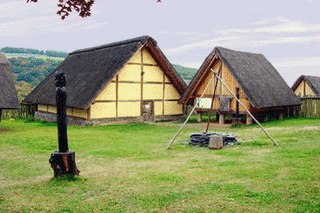
The Treveri were a Germanic or Celtic tribe of the Belgae group who inhabited the lower valley of the Moselle in modern day Germany from around 150 BCE, if not earlier, until their displacement by the Franks. Their domain lay within the southern fringes of the Silva Arduenna, a part of the vast Silva Carbonaria, in what are now Luxembourg, southeastern Belgium and western Germany; its centre was the city of Trier, to which the Treveri give their name. Celtic in language, according to Tacitus they claimed Germanic descent. They contained both Gallic and Germanic influences.
The Volcae were a Gallic tribal confederation constituted before the raid of combined Gauls that invaded Macedonia c. 270 BC and fought the assembled Greeks at the Battle of Thermopylae in 279 BC. Tribes known by the name Volcae were found simultaneously in southern Gaul, Moravia, the Ebro valley of the Iberian Peninsula, and Galatia in Anatolia. The Volcae appear to have been part of the late La Tène material culture, and a Celtic identity has been attributed to the Volcae, based on mentions in Greek and Latin sources as well as onomastic evidence. Driven by highly mobile groups operating outside the tribal system and comprising diverse elements, the Volcae were one of the new ethnic entities formed during the Celtic military expansion at the beginning of the 3rd century BC. Collecting in the famous excursion into the Balkans, ostensibly, from the Greek point of view, to raid Delphi, a branch of the Volcae split from the main group on the way into the Balkans and joined two other tribes, the Tolistobogii and the Trocmi, to settle in central Anatolia and establish a new identity as the Galatians.
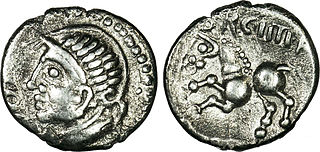
Orgetorix was a wealthy aristocrat among the Helvetii, a Celtic-speaking people residing in what is now Switzerland during the consulship of Julius Caesar of the Roman Republic.

The Battle of the Arar was fought between the migrating tribes of the Helvetii and six Roman legions — The Seventh, Eighth, Ninth, Tenth legions, Eleventh and Twelfth Legions — under the command of Gaius Julius Caesar in 58 BC. It was the first major battle of the Gallic Wars and ended in a tactical victory for the outnumbered Roman army.
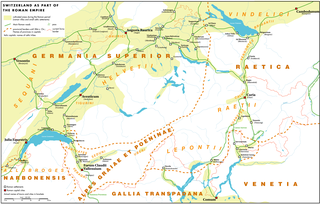
Aventicum was the largest town and capital of Roman Switzerland. Its remains are beside the modern town of Avenches.
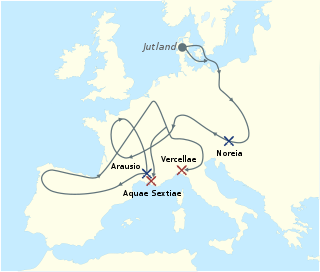
The Ambrones were an ancient tribe mentioned by Roman authors. They are believed by some to have been a Germanic tribe from Jutland; the Romans were not clear about their exact origin.

The Pictones were a Gallic tribe dwelling south of the Loire river, in the modern departments of Vendée, Deux-Sèvres and Vienne, during the Iron Age and Roman period.

The Condrusi were an ancient Belgic-Germanic tribe dwelling in what is now eastern Belgium during the Gallic Wars and the Roman period. Their ethnic identity remains uncertain. Caesar described them as part of the Germani Cisrhenani, but their tribal name is probably of Celtic origin. Like other Germani Cisrhenani tribes, it is possible that their old Germanic endonym came to be abandoned after a tribal reorganization, that they received their names from their Celtic neighbours, or else that they were fully or partially assimilated into Celtic culture at the time of the Roman invasion of the region in 57 BC.

The Cimbrian or Cimbric War was fought between the Roman Republic and the Germanic and Celtic tribes of the Cimbri and the Teutons, Ambrones and Tigurini, who migrated from the Jutland peninsula into Roman-controlled territory, and clashed with Rome and her allies. The Cimbrian War was the first time since the Second Punic War that Italia and Rome itself had been seriously threatened.

In ancient Rome, the Latin word pagus was an administrative term designating a rural subdivision of a tribal territory, which included individual farms, villages, and strongholds serving as refuges, as well as an early medieval geographical term. From the reign of Diocletian onwards, the pagus referred to the smallest administrative unit of a province. These geographical units were used to describe territories in the Merovingian and Carolingian periods, without any political or administrative meaning.

The Rauraci or Raurici were a small Gallic tribe dwelling in the Upper Rhine region, around the present-day city of Basel, during the Iron Age and the Roman period.

The Gauls were a group of Celtic peoples of mainland Europe in the Iron Age and the Roman period. Their homeland was known as Gaul (Gallia). They spoke Gaulish, a continental Celtic language.

Divico was a Celtic king and the leader of the Helvetian tribe of the Tigurini. During the Cimbrian War, in which the Cimbri and Teutons invaded the Roman Republic, he led the Tigurini across the Rhine to invade Gaul in 109 BC. He defeated a Roman army near present-day Agen on the Garonne river at the Battle of Burdigala in 107 BC, killing its leaders Lucius Cassius Longinus, the Roman consul, and Lucius Calpurnius Piso Caesoninus. Eventually he led his people back to the tribes of the Helvetii, near present-day Switzerland where they settled in the Jura Mountains near Lac Leman. 49 years later, before the Battle of Bibracte, he led a delegation back to Gaul to negotiate for a safe passage for his tribe through the Roman region of Provence. The request was denied by Caesar who wanted revenge for a relative who had been killed in the battle near Agen in 107 BC.

The Tulingi were a small tribe closely allied to the Celtic Helvetii in the time of Julius Caesar's conquest of Gaul. Their location is unknown; their language and descent are uncertain. From their close cooperation with the Helvetii it can be deduced that they were probably neighbours of the latter. At the Battle of Bibracte in 58 BCE, they were, with the Boii and a few other smaller tribes, allies of the Helvetii against the Roman legions of Caesar.
Potin is a base metal alloy used in coins. It is typically a mixture of copper, tin and lead and does not typically contain significant precious metals. Potin is usually used in reference to Celtic coinage.

Turicum was a Gallo-Roman settlement at the lower end of Lake Zurich, and precursor of the city of Zürich. It was situated within the Roman province of Germania Superior) and near the border to the province of Raetia; there was a tax-collecting point for goods traffic on the waterway Walensee–Obersee-Zürichsee–Limmat–Aare–Rhine.
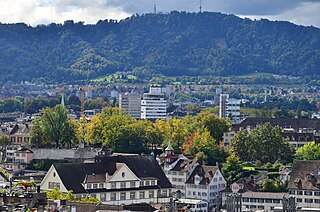
Lindenhof is the present name of the large fortified settlement, or oppidum, likely founded by the Helvetii on the Lindenhof hill on the western shore of the Limmat in Zürich, Switzerland.




















